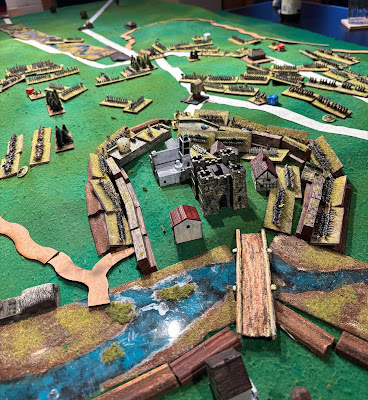As mentioned in a previous post, Henry arrived outside Königgrätz where he discovered Serbelloni had arrived ahead of him. Circling the city around the north, having crossed the upper Elbe, he found that the Austrians were camped on the plateau immediately to his south.*
* This was all rather convenient because I found a map of the 1866 battle. In game terms it mattered not, but at least it was a map of the general area. And it gave the smaller Prussian force an opportunity to keep out of sight of the Austrian heavy artillery which had caused them problems in the battle at Jaromiersch.
Rather than decline battle, and risk some losses as he retreated back the way he came, Henry decided to stand his ground. He positioned his force behind the westernmost of the small hills. His infantry (1 brigade of fusiliers and 1 small brigade of musketeers) were behind the crest. A brigade hussars were on the infantry's right to threaten any Austrian attack that tried to come through the gap between the wood and the stream. A brigade of dragoons was on the low ground to the infantry's left to threaten any Austrians that tried to approach along that waterway that flows into the Elbe (bottom right). Two battalions of Freikorps infantry were available to move to either flank of the infantry should it be necessary.
 |
| Plan of the approximate positions and the advance of the Austrian army. |
The Austrian army having got word of Henry's force, waited north of their camp. After cavalry vedettes reported no further site of the Prussians since they went behind the hills, Serbelloni ordered his army forward to deploy along the northern edge of the plateau.
The respective orders of battle were as follows.
Prussians (Prince Henry)
- Infantry: 2 brigades (1 weakened by the recent action)
- Cavalry: 2 brigades (1 dragoons, 1 hussars)
- Freikorps: 2 battalions
Austrians (Count Serbelloni)
- Cavalry: 4 brigades (2 cuirassiers, 1 dragoon, 1 hussar)
- Infantry: 7 brigades (1 grenadier, 6 musketeer)
- Artillery: 2 brigades of heavy guns
You can see why Henry chose to dispose his force in a Wellingtonian manner!
Serbelloni ordered his left wing of cavalry (1 cuirassier, 1 hussar) around the west of the wood. The infantry (2 lines of musketeers and a reserve of grenadiers) and the guns advanced in the centre whilst the right wing of cavalry (1 cuirassier, 1 dragoon) peeled off to the right.
As the infantry came down the slope they split into two wings - one heading towards the hill behind which were the Prussians, the other forming column diverged wide to the right, behind the cavalry. This all took some time for everything to get in position. When they did the Prussian dragoons caught the right wing cuirassiers before they could charge! The Austrians were pushed back and had to rally behind their own dragoons. The Prussian success was short-lived as the fresh Austrian dragoons got the better of the disordered Prussians. Following that, the cuirassiers were able to return to the fray whereupon they routed the Prussians!
On the left things did not go better for the Prussians. The Austrian heavies soon chased the Prussian hussars off. The Austrians now were threatening both flanks of Henry's infantry, and had their own infantry approaching the hill from the south. Returning to ease the pressure on their comrades, the Prussian hussars tried their luck again. They failed miserably.
In the course of seeing off the Prussian hussars, the Austrian left wing cavalry got too close to the Prussian Freikorps and took some casualties. But the end was approaching. The Austrian infantry on the hill was getting close, as was one brigade of guns. The infantry wing that had swept round the left flank of the Prussians were forming up on line. Both Austrian cavalry wings threatened the Prussian flanks. Henry tried a fighting withdrawal but it was to no avail. The Freikorps were routed by the Austrian left wing cavalry, and the Austrian right wing crushed the Prussian line from the other flank. Henry went down with his fusiliers. His small force ceased to exist.
The moth, drawn to the candle, got lucky once. But not twice. Once the Prussian cavalry wings were defeated the writing was on the wall. Serbelloni had his victory!
In a way, Henry was the victim of his own success. Down to 50% of his force, an Army morale test was taken, and passed. Twice. This meant the remaining units were cut down where they stood. Apologies, but I had no pictures from this game as I got caught up in the action.
The loss of so many men and the loss of his brother would come as a blow to the King after his victory outside Prague. Henry had fulfilled the brief set out for him tying up Serbelloni for so long, but would the cost be too great?



































